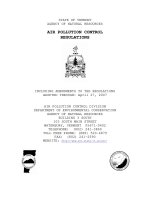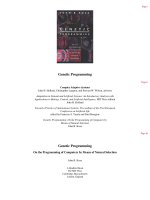- Trang chủ >>
- Khoa Học Tự Nhiên >>
- Vật lý
mathematic principals of natural philosophy
Bạn đang xem bản rút gọn của tài liệu. Xem và tải ngay bản đầy đủ của tài liệu tại đây (116.73 KB, 11 trang )
THE MATHEMATICAL PRINCIPLES OF
NATURAL PHILOSOPHY
(BOOK 1, SECTION 1)
By
Isaac Newton
Translated into English by
Andrew Motte
Edited by David R. Wilkins
2002
NOTE ON THE TEXT
Section I in Book I of Isaac Newton’s Philosophiæ Naturalis Principia Mathematica is
reproduced here, translated into English by Andrew Motte. Motte’s translation of Newton’s
Principia, entitled The Mathematical Principles of Natural Philosophy was first published in
1729.
David R. Wilkins
Dublin, June 2002
i
SECTION I.
Of the method of first and last ratio’s of quantities,
by the help whereof we demonstrate the propositions
that follow.
Lemma I.
Quantities, and the ratio’s of quantities, which in any finite time converge continually
to equality, and before the end of that time approach nearer the one to the other than by any
given difference, become ultimately equal.
If you deny it; suppose them to be ultimately unequal, and let D be their ultimate
difference. Therefore they cannot approach nearer to equality than by that given difference
D; which is against the supposition.
Lemma II.
If in any figure A a c E terminated by the right lines A a, A E, and the curve a c E, there
be inscrib’d any number of parallelograms A b, B c, C d, &c. comprehended under equal bases
A B, B C, C D, &c. and the sides B b, C c, D d, &c. parallel to one side A a of the figure; and
the parallelograms a K b l, b L c m, c M d n, &c. are compleated. Then if the breadth of those
parallelograms be suppos’d to be diminished, and their number to be augmented in infinitum:
I say that the ultimate ratio’s which the inscrib’d figure A K b L c M d D, the circumscribed
figure A a l b m c n d o E, and the curvilinear figure A a b c d E, will have to one another, are
ratio’s of equality.
A B C D E
a
b
c
d
K
L
M
l
m
n
o
F
f
1
For the difference of the inscrib’d and circumscrib’d figures is the sum of the parallelo-
grams K l, L m, M n, D o, that is, (from the equality of all their bases) the rectangle under
one of their bases K b and the sum of their altitudes A a, that is, the rectangle A B l a. But
this rectangle, because its breadth A B is suppos’d diminished in infinitum, becomes less than
any given space. And therefore (By Lem. I.) the figures inscribed and circumscribed become
ultimately equal one to the other; and much more will the intermediate curvilinear figure be
ultimately equal to either. Q.E.D.
Lemma III.
The same ultimate ratio’s are also ratio’s of equality, when the breadths, A B, B C, D C,
&c. of the parallelograms are unequal, and are all diminished in infinitum.
For suppose A F equal to the greatest breadth, and compleat the parallelogram F A a f.
This parallelogram will be greater than the difference of the inscrib’d and circumscribed
figures; but, because its breadth A F is diminished in infinitum, it will become less than any
given rectangle. Q.E.D.
Cor. 1. Hence the ultimate sum of those evanescent parallelograms will in all parts
coincide with the curvilinear figure.
Cor. 2. Much more will the rectilinear figure, comprehended under the chords of the
evanescent arcs a b, b c, c d, &c. ultimately coincide with the curvilinear figure.
Cor. 3. And also the circumscrib’d rectilinear figure comprehended under the tangents
of the same arcs.
Cor. 4. And therefore these ultimate figures (as to their perimeters a c E,) are not
rectilinear, but curvilinear limits of rectilinear figures.
Lemma IV.
If in two figures A a c E, P p r T you inscribe (as before) two ranks of parallelograms, an
equal number in each rank, and when their breadths are diminished in infinitum, the ultimate
ratio’s of the parallelograms in one figure to those in the other, each to each respectively, are
the same; I say that those two figures A a c E, P p r T, are to one another in that same ratio.
A E
a
c
P T
p
r
2
For as the parallelograms in the one are severally to the parallelograms in the other, so
(by composition) is the sum of all in the one to the sum of all in the other; and so is the one
figure to the other; because (by Lem. 3.) the former figure to the former sum, and the latter
figure to the latter sum are both in the ratio of equality. Q.E.D.
Cor. Hence if two quantities of any kind are any how divided into an equal number of
parts: and those parts, when their number is augmented and their magnitude diminished in
infinitum, have a given ratio one to the other, the first to the first, the second to the second,
and so on in order: the whole quantities will be one to the other in that same given ratio. For
if, in the figures of this lemma, the parallelograms are taken one to the other in the ratio of
the parts, the sum of the parts will always be as the sum of the parallelograms; and therefore
supposing the number of the parallelograms and parts to be augmented, and their magnitudes
diminished in infinitum, those sums will be in the ultimate ratio of the parallelogram in the
one figure to the correspondent parallelogram in the other; that is, (by the supposition) in
the ultimate ratio of any part of the one quantity to the correspondent part of the other.
Lemma V.
In similar figures, all sorts of homologous sides, whether curvilinear or rectilinear, are
proportional; and the area’s are in the duplicate ratio of the homologous sides.
Lemma VI.
If any arc A C B given in position is subtended by its chord A B, and in any point A in
the middle of the continued curvature, is touch’d by a right line A D, produced both ways;
then if the points A and B approach one another and meet, I say the angle B A D, contained
between the chord and the tangent, will be diminished in infinitum, and ultimately will vanish.
A
C
B
D
b
d
c
R
r
For if that angle does not vanish, the arc A C B will contain with the tangent A D an
angle equal to a rectilinear angle; and therefore the curvature at the point A will not be
continued, which is against the supposition.
3
Lemma VII.
The same things being supposed; I say, that the ultimate ratio of the arc, chord, and
tangent, any one to any other, is the ratio of equality.
For while the point B approaches towards the point A, consider always A B and A D
as produc’d to the remote points b and d, and parallel to the secant B D draw b d: and let
the arc A c b be always similar to the arc A C B. Then supposing the points A and B to
coincide, the angle d A b will vanish, by the preceding lemma; and therefore the right lines
A b, A d (which are always finite) and the intermediate arc A c b will coincide, and become
equal among themselves. Wherefore the right lines A B, A D, and the intermediate arc A C B
(which are always proportional to the former) will vanish; and ultimately acquire the ratio
of equality. Q.E.D.
A
B
C
DE
F
G
Cor. 1. Whence if through B we draw B F parallel to the tangent, always cutting any
right line A F passing through A in F; this line B F will be ultimately in the ratio of equality
with the evanescent arc A C B; because, compleating the parallelogram A F B D, it is always
in a ratio of equality with A D.
Cor. 2. And if through B and A more right lines are drawn as B E, B D, A F , A G
cutting the tangent A D and its parallel B F; the ultimate ratio of all the abscissa’s A D,
A E, B F , B G, and of the chord and arc A B, any one to any other, will be the ratio of
equality.
Cor. 3. And therefore in all our reasoning about ultimate ratio’s, we may freely use any
one of those lines for any other.
Lemma VIII.
If the right lines A R, B R, with the arc A C B, the chord A B, and the tangent A D,
constitute three triangles R A B, R A C B, R A D, and the points A and B approach and meet:
I say that the ultimate form of these evanescent triangles is that of similitude, and their
ultimate ratio that of equality.
For while the point B approaches towards the point A consider always A B, A D, A R, as
produced to the remote points b, d, and r, and r b d as drawn parallel to R D, and let the arc
A c b be always similar to the arc A C B. Then supposing the points A and B to coincide, the
angle b A d will vanish; and therefore the three triangles r A b, r A c b, r A d, (which are always
finite) will coincide, and on that account become both similar and equal. And therefore the
4
A
C
B
D
b
d
c
R
r
triangles R A B, R A C B, R A D, which are always similar and proportional to these. will
ultimately become both similar and equal among themselves. Q.E.D.
Cor. And hence in all our reasonings about ultimate ratio’s, we may indifferently use
any one of those triangles for any other.
Lemma IX.
If a right line A E, and a curve line A B C, both given by position, cut each other in a
given angle A; and to that right line, in another given angle, B D, C E, are ordinately applied,
meeting the curve in B, C; and the points B and C together, approach towards, and meet in,
the point A: I say that the area’s of the triangles A B D, A C E, will ultimately be one to the
other in the duplicate ratio of the sides.
A
B
C
D
E
F
G
b
c
d
e
f
g
For while the points B, C approach towards the point A, suppose always A D to be
produced to the remote points d and e, so as A d, A e may be proportional to A D, A E; and
the ordinates d b, e c, to be drawn parallel to the ordinates D B and E C, and meeting A B
5
and A C produced in b and c. Let the curve A b c be similar to the curve A B C, and draw
the right line A g so as to touch both curves in A, and cut the ordinates D B, E C, d b, e c, in
F , G, f, g. Then supposing the length A e to remain the same, let the points B and C meet
in the point A; and the angle c A g vanishing, the curvilinear areas A b d, A c e will coincide
with the rectilinear areas A f d, A g e; and therefore (by Lem. 5) will be one to the other in
the duplicate ratio of the sides A d, A e. But the areas A B D, A C E are always proportional
to these areas, and so the sides A D, A E are to these sides. And therefore the areas A B D,
A C E are ultimately one to the other in the duplicate ratio of the sides A D, A E. Q.E.D.
Lemma X.
The spaces which a body describes by any finite force urging it, whether that force is
determined and immutable, or is continually augmented or continually diminished, are in the
very beginning of the motion one to the other in the duplicate ratio of the times.
Let the times be represented by the lines A D, A E, and the velocities generated in those
times by the ordinates D B, E C. The spaces described with these velocities will be as the
areas A B D, A C E, described by those ordinates, that is, at the very beginning of the motion
(by Lem. 9) in the duplicate ratio of the times A D, A E. Q.E.D.
Cor. 1. And hence one may easily infer, that the errors of bodies describing similar
parts of similar figures in proportional times, are nearly in the duplicate ratio of the times
in which they are generated; if so be these errors are generated by any equal forces similarly
applied to the bodies, and measur’d by the distances of the bodies from those places of the
similar figures, at which, without the action of those forces, the bodies would have arrived in
those proportional times.
Cor. 2. But the errors that are generated by proportional forces similarly applied to the
bodies at similar parts of the similar figures, are as the forces and the squares of the times
conjunctly.
Cor. 3. The same thing is to be understood of any spaces whatsoever described by
bodies urged with different forces. All which, in the very beginning of the motion, are as the
forces and the squares of the times conjunctly.
Cor. 4. And therefore the forces are as the spaces described described in the very
beginning of the motion directly, and the squares of the times inversly.
Cor. 5. And the squares of the times are as the spaces describ’d directly and the forces
inversly.
Scholium.
If in comparing indetermined quantities of different sorts one with another, any one is
said to be as any other directly or inversly: the meaning is, that the former is augmented or
diminished in the same ratio with the latter, or with its reciprocal. And if any one is said to
be as any other two or more directly or inversly: the meaning is, that the first is augmented
or diminished in the ratio compounded of the ratio’s in which the others, or the reciprocals
of the others, are augmented or diminished. As if A is said to be as B directly and C directly
and D inversly: the meaning is, that A is augmented or diminished in the same ratio with
B × C ×
1
D
, that is to say, that A and
B C
D
are one to the other in a given ratio.
6
Lemma XI.
The evanescent subtense of the angle of contact, in all curves, which at the point of
contact have a finite curvature, is ultimately in the duplicate ratio of the subtense of the
conterminate arc.
A D
C B
G
J
d
c
b
g
Case 1. Let A B be that arc, A D its tangent, B D the subtense of the angle of contact
perpendicular on the tangent, A B the subtense of the arc. Draw B G perpendicular to the
subtense A B, and A G to the tangent A D, meeting in G; then let the points D, B and G,
approach to the points d, b and g, and suppose J to be the ultimate intersection of the lines
B G, A G, when the points D, B have come to A. It is evident that the distance G J may
be less than any assignable. But (from the nature of the circles passing through the points
A, B, G; A, b, g) A B
2
= A G × B D, and A b
2
= A g × b d; and therefore the ratio of A B
2
to
A b
2
is compounded of the ratio’s of A G to A g and of B D to b d. But because G J may be
assum’d of less length than any assignable, the ratio of A G to A g may be such as to differ
from the ratio of equality by less than any assignable difference; and therefore the ratio of
A B
2
to A b
2
may be such as to differ from the ratio of B D to b d by less than any assignable
difference. Therefore, by Lem. 1. the ultimate ratio of A B
2
to A b
2
is the same with the
ultimate ratio of B D to b d. Q.E.D.
Case 2. Now let B D be inclined to A D in any given angle, and the ultimate ratio of
B D to b d will always be the same as before, and therefore the same with the ratio of A B
2
to A b
2
. Q.E.D.
Case 3. And if we suppose the angle D not to be given, but that the right line B D
converges to a given point, or is determined by any other condition whatever; nevertheless,
the angles D, d, being determined by the same law, will always draw nearer to equality, and
approach nearer to each other than by any assigned difference, and therefore, by Lem. 1, will
at last be equal, and therefore the lines B D, b d are in the same ratio to each other as before.
Q.E.D.
7
Cor. 1. Therefore since the tangents A D, A d, the arcs A B, A b, and their sines B C,
b c, become ultimately equal to the chords A B, A b; their squares will ultimately become as
the subtenses B D, b d.
Cor. 2. Their squares are also ultimately as the versed sines of the arcs, bisecting the
chords, and converging to a given point. For those versed sines are as the subtenses B D, b d.
Cor. 3. And therefore the versed sine is in the duplicate ratio of the time in which a
body will describe an arc with a given velocity.
Cor. 4. The rectilinear triangles A D B, A d b are ultimately in the triplicate ratio of
the sides A D, A d, and in a sesquiplicate ratio of the sides D B, d b; as being in the ratio
compounded of the sides A D to D B, and of A d to d b. So also the triangles A B C, A b c are
ultimately in the triplicate ratio of the sides B C, b c. What I call the sesquiplicate ratio is
the subduplicate of the triplicate, as been compounded of the simple and subduplicate ratio.
Cor. 5. And because D B, d b are ultimately parallel and in the duplicate ratio of the
lines A D, A d: the ultimate curvilinear areas A D B, A d b will be (by the nature of the
parabola) two thirds of the rectilinear triangles A D B, A d b; and the segments A B, A b will
be one third of the same triangles. And thence those areas and those segments will be in the
triplicate ratio as well of the tangents A D, A d; as of the chords and arcs A B, A b.
Scholium.
But we have all along supposed the angle of contact to be neither infinitely greater nor
infinitely less, than the angles of contact made by circles and their tangents; that is, that the
curvature at the point A is neither infinitely small nor infinitely great, or that the interval
A J is of a finite magnitude. For D B may be taken as A D
3
: in which case no circle can be
drawn through the point A, between the tangent A D and the curve A B, and therefore the
angle of contact will be infinitely less than those of circles. And by a like reasoning if D B be
made successively as A D
4
, A D
5
, A D
6
, A D
7
, &c. we shall have a series of angles of contact,
proceeding in infinitum, wherein every succeeding term is infinitely less than the preceding.
And if D B be made successively as A D
2
, A D
3
2
, A D
4
3
, A D
5
4
, A D
6
5
, A D
7
6
, &c. we shall
have another infinite series of angles of contact, the first of which is of the same sort with
those of circles, the second infinitely greater, and every succeeding one infinitely greater than
the preceding. But between any two of these angles another series of intermediate angles
of contact may be interposed proceeding both ways in infinitum, wherein every succeeding
angle shall be infinitely greater, or infinitely less than the preceding. As if between the terms
A D
2
and A D
3
there were interposed the series A D
13
6
, A D
11
5
, A D
9
4
, A D
7
3
, A D
5
2
, A D
8
3
,
A D
11
4
, A D
14
5
, A D
17
6
, &c. And again between any two angles of this series, a new series of
intermediate angles may be interpolated, differing from one another by infinite intervals. Nor
is nature confin’d to any bounds.
Those things which have been demonstrated of curve lines and the superficies which they
comprehend, may be easily applied to the curve superficies and contents of solids. These
lemmas are premised, to avoid the tediousness of deducing perplexed demonstrations ad
absurdum, according to the method of the ancient geometers. For demonstrations are more
contracted by the method of indivisibles: But because the hypothesis of indivisibles seems
somewhat harsh, and therefore that method is reckoned less geometrical; I chose rather to
reduce the demonstrations of the following propositions to the first and last sums and ratio’s
8
of nascent and evanescent quantities, that is, to the limits of those sums and ratio’s; and so
to premise, as short as I could, the demonstrations of those limits. For hereby the same thing
is perform’d as by the method of indivisibles; and now those principles being demonstrated,
we may use them with more safety. Therefore if hereafter, I should happen to consider
quantities as made up of particles, or should use little curve lines for right ones; I would not
be understood to mean indivisibles, but evanescent divisible quantities; not the sums and
ratio’s of determinate parts, but always the limits of sums and ratio’s: and that the force of
such demonstrations always depends on the method lay’d down in the foregoing lemma’s.
Perhaps it may be objected, that there is no ultimate proportion of evanescent quantities;
because the proportion, before the quantities have vanished, is not the ultimate, and when
they are vanished, is none. But by the same argument it may be alledged, that a body arriving
at a certain place, and there stopping, has no ultimate velocity; because the velocity, before
the body comes to the place, is not its ultimate velocity; when it has arrived, is none. But
the answer is easy; for by the ultimate velocity is meant that with which the body is moved,
neither before it arrives at its last place and the motion ceases, nor after, but at the very
instant it arrives; that is, that velocity with which the body arrives at its last place, and with
which the motion ceases. An in like manner, by the ultimate ratio of evanescent quantities is
to be understood the ratio of the quantities, not before they vanish, nor afterwards, but with
which they vanish. In like manner the first ratio of nascent quantities is that with which they
begin to be. And the first or last sum is that with which they begin and cease to be (or to
be augmented or diminished.) There is a limit which the velocity at the end of the motion
may attain, but not exceed. This is the ultimate velocity. And there is the like limit in all
quantities and proportions that begin and cease to be. And since such limits are certain and
definite, to determine the same is a problem strictly geometrical. But whatever is geometrical
we may be allowed to use in determining and demonstrating any other thing that is likewise
geometrical.
It may also be objected, that if the ultimate ratio’s of evanescent quantities are given,
their ultimate magnitudes will be also given: and so all quantities will consist of indivisibles,
which is contrary to what Euclid has demonstrated concerning incommensurables, in the 10th
book of his Elements. But this objection is founded on a false supposition. For those ultimate
ratio’s with which quantities vanish, are not truly the ratio’s of ultimate quantities, but limits
towards which the ratio’s of quantities, decreasing without limit, do always converge; and to
which they approach nearer than by any given difference, but never go beyond, nor in effect
attain to, till the quantities are diminished in infinitum. This thing will appear more evident
in quantities infinitely great. If two quantities, whose difference is given, be augmented in
infinitum, the ultimate ratio of these quantities will be given, to wit, the ratio of equality;
but it does not from thence follow, that the ultimate or greatest quantities themselves, whose
ratio that is, will be given. Therefore if in what follows, for the sake of being more easily
understood, I should happen to mention quantities as least, or evanescent, or ultimate; you
are not to suppose that the quantities of any determinate magnitude are meant, but such as
are conceiv’d to be always diminished without end.
9









